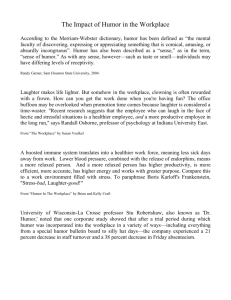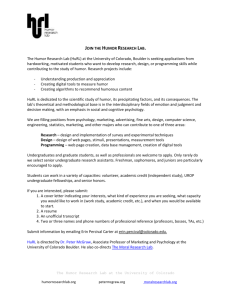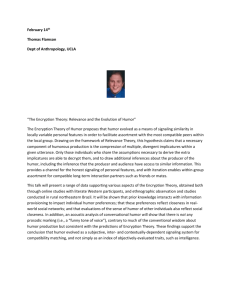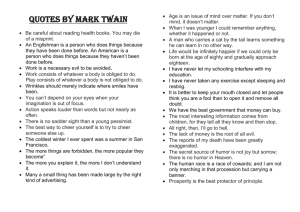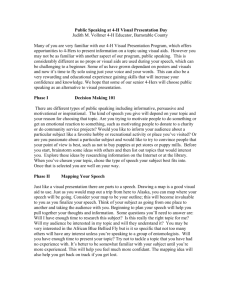HUMOR IN - SAIDNA ZULFIQAR BIN TAHIR (VIKAR)
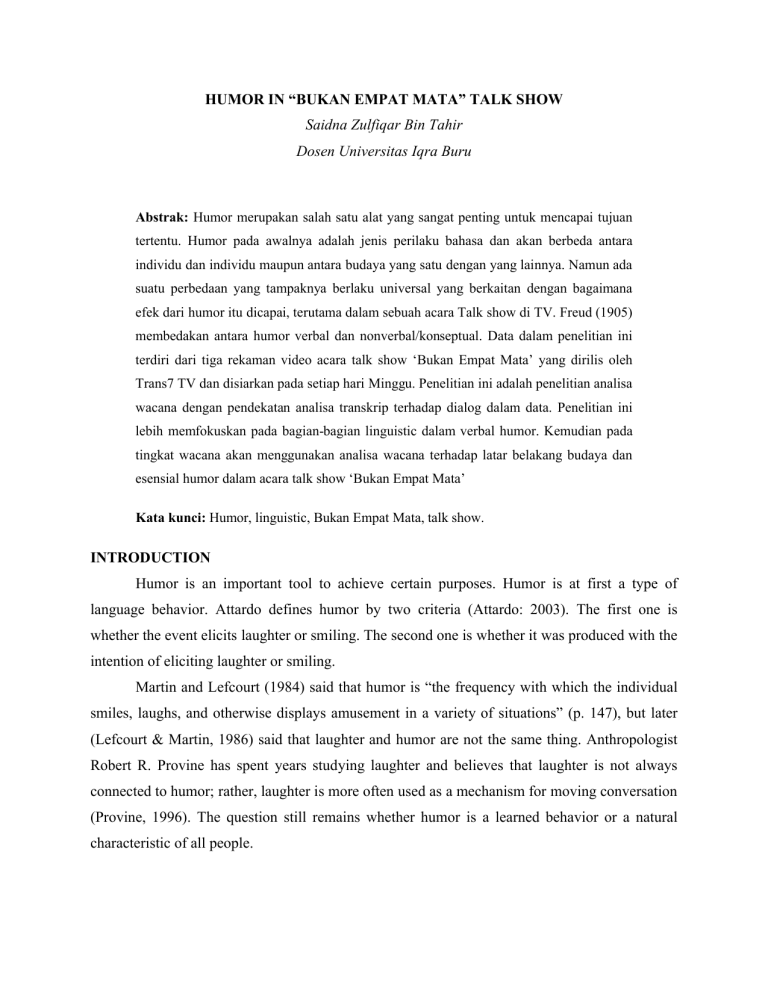
HUMOR IN “BUKAN EMPAT MATA” TALK SHOW
Saidna Zulfiqar Bin Tahir
Dosen Universitas Iqra Buru
Abstrak: Humor merupakan salah satu alat yang sangat penting untuk mencapai tujuan tertentu. Humor pada awalnya adalah jenis perilaku bahasa dan akan berbeda antara individu dan individu maupun antara budaya yang satu dengan yang lainnya. Namun ada suatu perbedaan yang tampaknya berlaku universal yang berkaitan dengan bagaimana efek dari humor itu dicapai, terutama dalam sebuah acara Talk show di TV. Freud (1905) membedakan antara humor verbal dan nonverbal/konseptual. Data dalam penelitian ini terdiri dari tiga rekaman video acara talk show ‘Bukan Empat Mata’ yang dirilis oleh
Trans7 TV dan disiarkan pada setiap hari Minggu. Penelitian ini adalah penelitian analisa wacana dengan pendekatan analisa transkrip terhadap dialog dalam data. Penelitian ini lebih memfokuskan pada bagian-bagian linguistic dalam verbal humor. Kemudian pada tingkat wacana akan menggunakan analisa wacana terhadap latar belakang budaya dan esensial humor dalam acara talk show ‘Bukan Empat Mata’
Kata kunci: Humor, linguistic, Bukan Empat Mata, talk show.
INTRODUCTION
Humor is an important tool to achieve certain purposes. Humor is at first a type of language behavior. Attardo defines humor by two criteria (Attardo: 2003). The first one is whether the event elicits laughter or smiling. The second one is whether it was produced with the intention of eliciting laughter or smiling.
Martin and Lefcourt (1984) said that humor is “the frequency with which the individual smiles, laughs, and otherwise displays amusement in a variety of situations” (p. 147), but later
(Lefcourt & Martin, 1986) said that laughter and humor are not the same thing. Anthropologist
Robert R. Provine has spent years studying laughter and believes that laughter is not always connected to humor; rather, laughter is more often used as a mechanism for moving conversation
(Provine, 1996). The question still remains whether humor is a learned behavior or a natural characteristic of all people.
Even though humor, as a linguistic and interactional process, appears to be a universal human phenomenon, it is more obviously embedded in situated socio-cultural context than most other communication. Discourse analysis has recently begun to explore humor in discourse from both the linguistic and socio-cultural perspective. In western context, an approach to humor grounded in interactional sociolinguistics starts not with reified abstractions such as “humor”,
“wit”, or “irony”, but rather with the situated interpretation of humor as a speech activity (Davies
2003).
The concept of talk shows on television, especially in Indonesia, has been considered as an event concept that will never be defeated rating soap operas or other entertainment programs.
Talk show is often considered boring, too hard to digest, not attractive packaging, and various other reasons that make the talk show increasingly marginalized in the affairs of the acquisition of rating. But the emergence of program Bukan empat Mata (B4M) in Trans7 TV provides another perspective on the business community and media in view of talk show program. In fact,
B4M talk show is able to break most people opinion about the talk show program called will never get a high rating.
The Program B4M is a talk show program that uses humor and always brings a perspective celebrity. This program Live at Trans7 TV, every Sunday. Starting at 22.00 – 23.00 pm. It contained 50% of the fresh jokes, 40% information (talk show) and 10% music. All dialogues will be packaged in a lightweight, relaxed, with styles of Tukul Arwana who previously aired episodes Summary: From the 2 episodes already aired, the star guest will feel relaxed and entertained. (Trans7: 2011). The success of this program was not apart from its presenter role, Tukul Arwana, a comedian multitalented that can entertain up to double up laughter with fresh expense and humor.
The success of this program was not apart from its presenter role, Tukul Arwana, a comedian multitalented that can entertain up to double up laughter with fresh expense and humor. Talking about interesting topics with the guest star, and always discuss the topics and cases that are widely in society and the unique and the interesting topics.
Tukul Arwana is a popular comedian and represent surprisingly different, nearly opposite characters, which justifies the interest in the study of his work. While analyzing his work, we first listened to the tape and transcribed the material, before watching his video performances, in order to get visual support of what he is talking about. This procedure gave us important insight
into his ways of performing the material by using paralanguage in form of gestures and various facial expressions. We realized that examples which did not seem to be funny while just listening to him became interesting and appropriate for our analysis when watching the video performances. This is the reason why we will also focus on the analysis of gestures and facial expressions in study, because we are repeatedly confronted with the contrast between his apathetic and monotonous style on the one hand, and his use of paralanguage on the other hand.
There are three reasons why the B4M Talk Show is chosen. The first reason is it is a comedy talk show. It is a feasible way to analyze humor in comedies. The second reason, is this talk show is the most popular dialect talk show in Indonesia. The third reason is, this talk show addresses social aspects of life through humor. This study takes an analytical of speaking approach to the data. The problem for analyzing the humor in a talk show is that it is easy for the analyzer to decide whether the conversation is humorous or not, for the reason that the response of the audience laughter.
The corpus for this study consists of three data from video performances of Bukan Empat
Mata Talk Show which were released by TRANS7 TV on 06 January 2009 with the title
“ Popularitas” and the guests were Rahma Azhari and Sarah Azhari (R&S), 27 December 2009 with the title “ Spesial Tahun Baru ” and the guests were Mama Laurent (ML) and Chaterin
Wilson (CW), and 15 January 2010 with the title “Camera , Roll Action ” with the guests Slamet
Rahardjo (SR) and Eross Djarot (ED). And the hosts were Tukul (T) and Vega (V).
In discussing how humor is built up in the talk show, first we analyze the linguistic devices are used for creating humorous effect in verbal interactions. Than the humorous effects result from the social interactions between (or among) the interlocutors and the audiences.
Humor
A standard definition for humor is hard to find. Martin and Lefcourt (1984) said that humor is “the frequency with which the individual smiles, laughs, and otherwise displays amusement in a variety of situations” (p. 147), but later (Lefcourt & Martin, 1986) said that laughter and humor are not the same thing. Anthropologist Robert R. Provine has spent years studying laughter and believes that laughter is not always connected to humor; rather, laughter is more often used as a mechanism for moving conversation (Provine, 1996). The question still remains whether humor is a learned behavior or a natural characteristic of all people.
The incongruity theory is the prevailing current theory on humor; it views humor as being primarily cognitive. This theory says that something is humorous because the event (joke, body movement, statement, for example) is incompatible with our expectations and causes a momentary cognitive struggle to resolve the perceived incongruity. Once the incongruity is resolved, the situation is perceived to be humorous. The most famous proponent of this theory is
Immanuel Kant, and other supporters have included Gerard, Beattie, Schopenhauer, Bergson,
Menon, and Willmann (Keith-Spiegel, 1972).
The superiority theory was formally developed by English philosopher Thomas Hobbes but has fallen out of favor in the past couple of decades. Proponents of this theory include
Aristotle, Plato, Meyerson, Sidis, and Wallis, although some theorists, such as Hunt, Carpenter,
McDougall, and Rapp, hold that this theory can also include laughter that is not always scornful, but is congenial and empathetic (Keith-Spiegel, 1972).
The third most prominent surviving theory is the relief theory, or psychoanalytic theory, which was introduced by Spencer (McGhee, 1983a) and popularized by Freud. (1905/1989)
According to this theory, humor is a socially acceptable way of releasing built-up tension and nervous energy. Everyone has certain areas that he or she finds uncomfortable, fearful, and/or embarrassing, and humor is a way of relieving this stress in a socially acceptable way. Other proponents of this theory include Kline, Gregory, Dewey, Patrick, Dooley, Feldmann, and
Wolfenstein (Keith-Spiegell, 1972).
The Function of Humor
Martineau (1972) discusses three functions of humor: consensus, conflict and control.
The term consensus refers to the reduction of social distance. The function of such humor is to initiate and solidify the development of social relationship. It therefore encompasses functions such as integration into a group, and creating solidarity. Conflict humor introduces or fosters conflict in a group. Ridicule is a form of humor that can effectively introduce conflict. The term control refers to the control of others. Humor is used to express grievances and to draw people’s attention to their mistakes. The control function is also discussed by Collinson (1988). He discusses humor on the shop floor, identifying three functions – to resist boredom, to conform and to control others. Collinson’s conform reflects the consensus category created by Martineau.
To resist boredom is a function not mentioned by Martineau. This will be the function of a large
number of instances, although probably not often the sole reason. A broader term is to amuse or to entertain.
Verbal humor versus conceptual humor
Even though humor differs from individual to individual and from culture to culture, there is one distinction which seems to apply universally, which has to do with how the humorous effect is achieved, and that is Freud's distinction between verbal humor and conceptual humor. Verbal humor is when an aspect of language, such as structural ambiguity, is exploited in order to achieve a humorous effect, while conceptual humor involves concepts or ideas that are thought of as humorous without using aspects of language for other purposes conveying the humorous message.
There are several areas of language in which there are units and structures which may be exploited in order to create incongruity, most of which involve ambiguity. Some of these are: a. Phonology: system of sounds in a language b. Graphology: written form of a language c. Morphology: the structure and organization of individual words d. Lexis: individual words of a language (and the relation between their form and their meaning) e. Syntax: how words are structured into meaningful strings of words
Each of these levels involve various types of conventions of language (or rules or whatever), which may be exploited by speakers in order to create humor-generating incongruity.
Social aspects of humor
Humor is very much a social phenomenon and serves various types of social or interpersonal purposes.
The social aspects of humor are reflected in the nature of laughter. Laughter typically occurs in groups of two or more people and rarely, or at least less frequently, when people are alone. Research into laughter and humor has shown that people who laugh at something in the company of others often do not laugh at the same thing when they are alone. Likewise, if an individual is in the company of other people who do not laugh at something, then this individual will typically stop finding it humorous. Conversely, being the only person who laughs at something in a group of people often results in embarrassment and awkwardness. Finally, an
individual who does not normally find something humorous may laugh at it, ending up seeing it as humorous after all, if in the company of other people who are laughing at it.
This means that not laughing at somebody's attempt at humor not only disproves of their sense of humor but also signals social distance and non-sympathy (it can of course also signal the failure to understand the joke etc.). Another consequence is that not laughing when other people laugh signal non-membership and non-allegiance with them.
The Effects of Humor
Many people praise the effect humor has on talk show process, but the literature on the effectiveness of humor is far from unanimous. Shade (1996), with all his statements about the usefulness of humor in talk show, acknowledges that, both a personal sense of humor and the use of humor in the work environment are essential.
Studying the effects of humor on Talk Show program in general has led to mixed results.
One of the main difficulties surrounding the issue of humor in TV programs is the multidimensionality of humor. Humor is at once cognitive, emotive, and psychological.
Differences among people’s personalities, experiences, and ideas lead to different concepts of what is funny. Disagreements concerning the definition of humor and the theories surrounding humor make humor research difficult and prone to debate. However, the research that has been conducted so far has yielded some significant results.
METHOD
The corpus for this study consists of three data from video performances of Bukan Empat
Mata Talk Show which were released by TRANS7 TV on 06 January 2009 with the title
“ Popularitas” and the guests were Rahma Azhari and Sarah Azhari (R&S), 27 December 2009 with the title “ Spesial Tahun Baru ” and the guests were Mama Laurent (ML) and Chaterin
Wilson (CW), and 15 January 2010 with the title “Camera , Roll Action ” with the guests Slamet
Rahardjo (SR) and Eross Djarot (ED). And the hosts were Tukul (T) and Vega (V). This study takes an analytical of speaking approach to the data.
In discussing how humor is built up in the talk show, first we analyze the linguistic devices which constitute humor. Then at the discourse level, we employ the approach of discourse analysis. We also examine two factors that are both deeply related to cultural background and essential to humor building up, that is, the irony and the use of dialects.
FINDING AND DISCUSSION
Linguistic Level
Although humor can be considered as the interaction between linguistic process and contextual reality and highly depended on the situation context, first of all, it is a kind of speech activity. Linguistic devices, such as the vocalization, the lexis and the syntax, are the important factors that construct humor. We divide linguistic devices into three levels: humor at the phonetic level, humor at the morphological level, and humor at the lexical level.
a. Phonetic Devices
Humor at the phonetic level is based on the homophones, the laughter particle, and some vocalization.
EXTRACT 2:
26 T : Ya, sama dengan saya waktu saya dengan angelina coli[ (..) ya to
Yes, so do I when I was be with Angelina Coli[ (..) right
[heh heheh] 27 A :
28 R&S : Apa angelina joly?
29 T
Angelina Joly, wasn’t she?
: Iya angelina jolie
30 V
Yep, Angelina Joly
: Angelina nori
31 T
Angelina Nory
: Angelina laela sari (..) lho kok cengengsean
Angelina Laela Sari (..)
35 R&S : Mas Tukul tau hanoman kan?
Mr. Tukul, Don’t you know about Hanoman?
36 T : Tau (.) sering nonton wayang orang kok
Yes (.) sometimes I watched it on Tv
37 R&S : Itu rahwana heh heheh
That was Rahwana heh heheh
38 T : Tukul arwana ‘artis berwajah merana’
Tukul Arwana the actor who has a sad face
In (26&38), the homophones ‘coli’ and ‘ joli’, ‘arwana’ and ‘merana’ are nearest pronounced in Indonesian slang and standard dialect raises the humorous effect from wordplay.
Wordplay is any humorous statement in which the humor derives from the meanings, sounds or ambiguities of words. This may involve a speaker deliberately punning, or a hearer identifying an ambiguity in the speaker’s speech and exploiting it for humorous effect.
Instance of 'defending' is using humor to avoid revealing personal information about oneself. 'To defend' is a category used by Ervin-Tripp and Lampert (1992) for Ziv's (1984) function: "protecting the self by identifying a weakness before anyone else does" (1984: 62). The label is used here to apply to any humor which is used to protect oneself. In (35), R&S is insecure about the similarity of T and Hanoman, T realizes that and makes excuses to protect himself from any criticism that may be forthcoming ‘tukul arwana artis berwajah merana’.
.
Another strategy found to creating humor at the phonetic level is using dialect and borrowing English. The regular language in talk show is the Indonesian slang, which represent an informal style. However, in recent years, a trend of using dialects and borrowing in talk show has become popular, which resists the dominant cultural discourse and conveys the tastes of ordinary people. Moreover, using dialects in talk show and humor always take place simultaneously. According to this function of using dialect, it gradually becomes an important measure to achieve humorous purpose in talk show.
Extract 2:
16 V
17 T
: Kalau gaya setan gimana?
What about the evil style?
: Setan (.) setan kepalalu bau menyan itu !!
Evil (.) evil your head smells like menyan
24 T : Akhir-akhir ini saya dengar banyak berita tentang kalian di infotainment, what’s wrong with you?
25 R&S : What’s wrong?what’swrong? heh heheh
26 T
What’s wrong?what’swrong?
: What’s wrong ? jelek amat sih [heh heheh
You’re so ugly to spell that
By using phonetic devices, the dialectal sounds contrasting with the pronunciations in
Standard Indonesian in (17) ‘kepalalu bau menyan’ or English in (25) what’s wrong with you’ and the laughter particles are the main trigger of humor.
b. Morphological Devices
There are several ways to use morphology sources of incongruity to generate humor-creating incongruity. One way to do that is to play around with different affixes that sound the same or with parts of free morphemes that look or sound likes affixes or compounding:
EXTRACT 3:
3 P : Istri saya sedang hamil (.) skarang masuk 6 bulan (..) gitu
My wife is pregnant now she’s in the sixth month (..) like that
4 ML:
5 V : Trus kira-kira anaknya mirip bapaknya gak?
[ehe]
So his son will be like his fathers, isn’t he?
6 A : heh heheh
7 P : Ya iyalah mirip gue, siapa lagi selain guembrot?
Offcourse he looks like me, who else except guembrot?
In (7), the different affix ‘gue’ and ‘guembrot’ in Indonesian slang dialect raises the humorous effect. According to Ziv (1984) defines one of the functions of humor as 'sharing similarities between self and others'. This category is for humor which identifies or celebrates shared ideas, shared interests, experiences and other similarities between speakers.
c. Lexical Devices
Humor created by lexical devices includes words and phrases. Most humor is based on two strategies: using word substitution and using vernacular dialectal slangs. Word substitution indicates that changing certain words in an established sentence in order to provide humor.
Homonymy/polysemy is a commonly used lexical source of incongruity. Here are some more examples:
EXTRACT 3:
16 T : Pepi kaki ama tangan gak ada bedanya (..) muka ama telapak kaki gak jauh[hhhh] beda
There’s no different between Pepi’s hand and foot (..) so does his face and arm
[heh heheh] 17 A :
18 V : Kan ada lagu buat Pepi
19 T :
Don’t you know that there was a song for Pepi
Apa lagunya?
What was its song?
20 V : Jempol semua jemarimu
21 A :
All his fingers like his thumb
[heh heheh]
In (16). First, T compares between “kaki and tangan” in the set phrase “pepi kaki ama tangan dak ada bedanya”. Then according to this comparative, the girl (V) responses by changing another word “jempol” which means the thumb. The similarity of the comparative in the sentence “jempol semua jemarimu” elicits smiles.
EXTRACT 1:
13 SR: Ini teroris nih
This is a terrorist
14 T : Teror? Emang tampang gue ada kesing-kesing teroris apa?
Terror? does my face looks like a terrorist casing?
In (14), the same strategy is used to create humor. Tampang “face” and kesing “casing” have the similar form but unrelated meanings. Through combining them together into one sentence, the discrepancy between the two words are more obvious, making this sentence humorous.
EXTRACT 1:
16 T : Berarti ABG itu
That means ABG
17 V : Apaan?
What does it mean?
18 T : Atas Bawah Gombyor
Up and down are bigger
19 A : heh heheh
Example (18) has already contains the strategy of using dialectal words. Using ‘gembyor’ instead of “bigger” increase the humorous effect. In dialect-used talk show, vernacular dialectal slangs are important linguistic devices for rendering humor at the lexical level. For example:
EXTRAXT 3:
7 P : Ya iyalah mirip gue, siapa lagi selain guembrot?
Offcourse he looks like me, who else except guembrot?
EXTRACT 1:
9 SR : Tau artinya sarden gak? Sarwo kedaden -banyak makan sarden kalo sudah besar bisa apa saja)
Do you know what sarden means? Sarwo Kedaden[ - eat much Sarden you can do everything when you grow up
EXTRACT 2:
10 T : Kalau aku kecil siapa yang mandiin?
Who has washed me when I was child?
11 V : kebo
Buffalo
The three examples are all dialectal slang of certain regions. (7) ‘guembrot’ is in Batavia slang, (9) ‘sarwokedaden’ is in Javanese dialect and (11) ‘kebo’ is in Indonesian/Javanese dialect. They are also the spoken tags for each character in the talk show, which are considered as the symbols of characters. Each of the three has its regional characteristic. When the characteristic is related to a specific cultural and the image of regional people, the audience will feel humorous.
Societal Perspective
In this talk show, there are two essential factors in constructing humor. One is irony which is a response to current social situations; another is the use of dialect. The two factors are
almost contained in every humorous conversation in the talk show. They are the main strategies the director uses to achieve humorous effect and to express critical views towards current social reality.
Irony in the talk show can be divided into two categories according to its content. The first category is using irony to satirize the so-called popular culture and modern artists in the society.
EXTRACT 1:
1 W : Sebenarnya aku pengen belajar acting lebih banyak mas dari (.) mas Slamet
Actually I’d like to learn more about acting from Mr. S
2 T : Pasti diterima[heh heheh]
Ofcourse he will accept you [heh heheh]
3 SR : Sudah cantik muslimah pula
She was so beauty and a muslim
4 A : heh heheh
5 T : Penyakit lama kambuh[
Old disease suffers a relapse
In (3), the irony is used to satirize the so-called modern artists. The term “sudah cantik muslimah pula” make the sentences sound like produced by a modern artist, who has a specific modernism or even postmodernism perspective. However, these expressions come from Slamet
Rahardjo who has an art education and political background.
Teasing is another strategy which can function in two ways. Teasing is not always antagonistic, but rather can function to express solidarity and rapport (see e.g. Strahle, 1993;
Hay, 1994). Some teasing primarily reinforces solidarity and expresses rapport, whereas other teases serve primarily to maintain the power of the teaser.
In (3), a simple, meaningful look is sufficient for W to realize she is being teased. T is the only member of the group that knows that SR has a crush on W. And she has frequently teased
W about this fact.
Another category of irony in the talk show is using irony to reflect the reality, namely, the social and political problems which the host and guest observe in old and current Indonesia. In the political and ideology context, these problems could only be implied through irony in a comedy.
EXTRACT 1:
30 ED : Sebentar(.)ada satu hal yang menarik (.) dia dulu kelas 4 saya kelas 3 (.) tapi setiap ulangan saya kasi tau dia terus
31 A :
32 T :
Wait a minute (.)there was something interested (.) when he (S) was in grade 4 I was in grade 3 (.) but every time he has an examination I told him the answers
[heh heheh
Tanda-tanda orang pintar kaya gini (.) pintar nyontek (..) ternyata joki itu gak mulai sekarang tapi dari dulu juga sudah ada[heh heheh
That were the signs of the smart people (.) smart to cheat (..) obviously the jokey happened from the past not nowadays
In (32) implies another social and educational problem in current Indonesia. Some critics toward the jokey in examination that became a custom that lower educational quality and toward some people named their selves by intellectualist whereas they have a title graduated illegally.
Ziv (1984) defines one of the functions of humor as 'sharing similarities between self and others'. This category is for humor which identifies or celebrates shared ideas, shared interests and other similarities between speakers. Example (30) includes humor which refers to shared experiences and humor which highlights similarities. The group is reminiscing about a course they took which was particularly tough, and during which they regularly stayed up in the examination of elementary school computer. ED recalls their examination. He is capitalizing on shared experiences.
Dialect using also plays an important role in creating humor in this talk show. The first role is contrasting with standard. Dialects are vernacular languages and considered as informal.
The default language in talk show is the Standard Indonesian, which represent a serious and formal style. The contrast between dialects and the Standard Indonesian can easily bring a sense of humor. When the characters use their dialects in a particular context, even just their own spoken tags, these usages can achieve humorous affects. The knowledge about the dialect and the imagination of the regional people will influence the humorous effect aroused by the dialect.
Besides the examples that are given in humor using phonetic devices and lexical devices, there are more examples:
Extract 1:
11 T :Kayaknya mas (S) kompak bangat sama mas Eros Jarot (.) remember masa kecil masih ingat acara sunatan mas berdua gak? Gara-gara uang 100 rupiah akhirnya mas Eros mau ngeliatin hasil sunatannya[
12 A :
(It seems like you (S) and Mr. Eross are solid, do you still remember the childhood story of both of you about the circumcision party? Because of 100 rupiahs, Mr Eross finally had shown his result of circumcision[
[heh heheh
7 T : Kaya gudeg gitu, gudeg itu makin lama makin enak dimakan makin mules [di perut
8 A :
Like a Guded (.) the more we kept it the more delicious to eat and the more we have the stomachache
[heh heheh
All the humorous effects in these examples have relationship with using dialect. In (11) T speaks in English dialect ‘remember’ and Indonesian standard and slang ‘acara sunatan’.’ngeliatin’. In (7) T not only uses Indonesian slang but also mentions a symbolic sculpture in Javanese dialect ‘mules and gudeg’.
Many instances of humor serve to create solidarity within the group or between particular members of the group. This section of the taxonomy identifies a number of primary strategies used to create solidarity and consensus. Sharing covers humors which reveal something about the speaker, and let the audience know them better. Many anecdotes fit into this category. The speaker allows the audience to know them better, and so positively affects solidarity. Sharing sensitive information also indicates a speaker's trust of the audience, and so can enhance solidarity.
CONCLUSION
In this paper I examine the humor in the Bukan Empat Mata Talk Show from two levels, namely, the linguistic level, the societal perspective context. The linguistic devices used for creating humorous effect in verbal interactions include phonetic, lexical and morphological devices. Irony to current societal situation in Indonesia results from the social interactions among interlocutors and the audiences.
Language choice and language form as dialects which contrast with standard, nonstandard and connection with local culture in the socio-cultural context of Indonesian slang and mixing English are used to create humor.
BIBLIOGRAPHY
Attardo, Salvatore. 2003. Introduction: The pragmatics of humor.
Journal of Pragmatics
35:1287-1294.
Boxer, Diana and Florencia Cortes-Conde.1997. From bonding to biting: Conversational joking and identity display. Journal of Pragmatics 27.275-294.
Davies, Catherine Evans. 2003. How English-learners joke with native speakers: An interactional sociolinguistic perspective on humor as collaborative discourse across cultures. Journal of Pragmatics 35.1361-1385.
Freud, S. (1989). Jokes and their Relation to the Unconscious. (J. Strachey, Trans.). New York:
W.W.Norton & Co. (Original work published 1905)
Godkewitsch, M. (1972). The relationship between arousal potential and funniness of jokes. In
J.H.Goldstein & P.E. McGhee (Eds.), The Psychology of Humor (pp. 143-158). New
York: Academic Press.
Hampes, W. P. (1992). Relation between intimacy and humor. Psychological Reports, 71 , 127-
130.
Keith-Spiegel, P. (1972). Early concepts of humor: Varieties and issues. In J.H.Goldstein & P.E.
McGhee (Eds.), The Psychology of Humor (pp. 4-39). New York: Academic Press.
Martin, R. A., & Lefcourt, H. M. (1984). Situational humor response questionnaire: Quantitative measure of sense of humor. Journal of Personality and Social Psychology, 47 (1), 145-
155.
Martineau, W.H. (1972). A model of the social functions of humor. In J.H.Goldstein &
P.E.McGhee (Eds.), The Psychology of Humor (pp. 101-125). New York: Academic
Press.
O’Connell, W.E. (1996). Freudian humor: The eupsychia of everyday life. In A.J. Chapman &
H.C. Foot (Eds.), Humor and Laughter: Theory, Research, and Applications (p. 313-330)
New Brunswick: Transaction Publishers.
Shade, R A. (1996). License to Laugh: Humor in the Classroom. Englewood, Colorado: Teachers
Ideas Press.
Solomon, J. C. (1996). Humor and aging well: A laughing matter or a matter of laughing?
(Aging Well in Contemporary Society, Part 2: Choices and Processes) American
Behavioral Scientist, 39 (3), 249-271.
Suls, J.M. (1972) Two-stage model for the appreciation of jokes and cartoons: An informationprocessing analysis. In J.H.Goldstein & P.E.McGhee (Eds.), The Psychology of Humor
(pp. 81-100). New York: Academic Press.
Education , 57 (1), 5-15.
http://www.trans7.co.id/frontend/home/view diakses pada 11 Maret 2011

